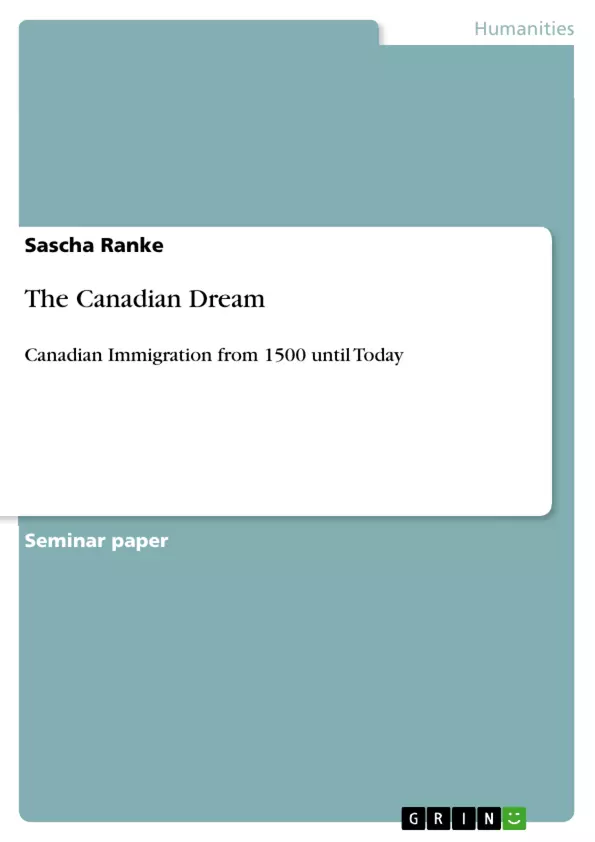This research paper deals with the immirgration history of Canada from 1500 until today.
It highlights the basic history of immgration studies and why they are important to the overall cultural context.
Furthermore, the paper investigates the immigration policy by the Canadian government and how this affects immigration laws and tendencies to this day.
Table of Contents
- 1. Introduction
- 2. The History of Immigration
- 2.1 Types of Immigrants
- 3. Immigration Policy
- 4. Conclusion
Objectives and Key Themes
This paper aims to explore the history of immigration to Canada from 1500 to the present day, contrasting it with the American Dream narrative. It investigates the reasons behind Canada's increasing appeal as an immigration destination and examines the various types of immigrants who have shaped the country's demographics and cultural landscape.
- The evolution of the Canadian Dream as an alternative to the American Dream.
- The historical overview of immigration to Canada, highlighting key periods and trends.
- Different types of immigrants to Canada (permanent residents, refugees).
- The role of immigration policy in shaping Canada's immigrant population.
- The demographic characteristics of Canadian immigrants (age, gender, origin).
Chapter Summaries
1. Introduction: This introductory chapter sets the stage by contrasting the allure of the American Dream with its disillusionment in recent decades. It then positions Canada as a rising alternative, introducing the concept of the "Canadian Dream" and highlighting the country's long history of immigration as a key factor in its appeal.
2. The History of Immigration: This chapter provides a broad historical overview of immigration to Canada, tracing it from its earliest settlements. It touches upon the scientific understanding of human migration, citing anthropological and genetic evidence to contextualize the long history of human movement across the globe. The chapter then delves into the specifics of Canadian immigration, emphasizing key periods such as the post-Revolutionary War influx of British loyalists, the westward expansion leading to a peak in immigration during the late 19th and early 20th centuries, and the impact of events like the Great Depression and World War II on immigration patterns. The chapter concludes by analyzing the more recent, relatively stable immigration numbers since 1990.
2.1 Types of Immigrants: This section delves into the categories of immigrants to Canada, primarily focusing on permanent residents and refugees. It highlights the Canadian government's stated objectives for immigration (family reunification, economic development, refugee protection) as outlined in the 2002 Immigration and Refugee Protection Act. Further analysis reveals the significant role of gender and age in understanding immigration patterns, noting the higher numbers of female immigrants since 1990 and discussing the origins of refugee populations. The chapter also briefly considers immigrants from the United States, noting their smaller but growing numbers.
Keywords
Canadian Dream, Immigration, Canada, Immigration Policy, Refugees, Permanent Residents, Historical Overview, Demographic Trends, American Dream.
Frequently Asked Questions: A Comprehensive Language Preview
What is the main topic of this language preview?
This language preview provides a comprehensive overview of the history of immigration to Canada, comparing it to the American Dream narrative. It analyzes immigration patterns, policies, and the different types of immigrants who have shaped Canada's demographics and cultural landscape.
What are the key themes explored in this preview?
Key themes include: the evolution of the "Canadian Dream" as an alternative to the "American Dream"; a historical overview of immigration to Canada, highlighting key periods and trends; different types of immigrants (permanent residents, refugees); the role of immigration policy; and the demographic characteristics of Canadian immigrants (age, gender, origin).
What is covered in the Introduction chapter?
The Introduction contrasts the allure and disillusionment of the American Dream with the rising appeal of the Canadian Dream, highlighting Canada's long history of immigration as a key factor in its attractiveness.
What does the chapter on "The History of Immigration" cover?
This chapter provides a broad historical overview of immigration to Canada, from its earliest settlements. It includes a scientific understanding of human migration, key periods like the post-Revolutionary War influx of British loyalists and westward expansion, and the impact of events such as the Great Depression and World War II on immigration patterns. It concludes by analyzing more recent, relatively stable immigration numbers since 1990.
What are the main points discussed in the section on "Types of Immigrants"?
This section focuses on the categories of immigrants to Canada, primarily permanent residents and refugees. It highlights the Canadian government's objectives for immigration (family reunification, economic development, refugee protection) as outlined in the 2002 Immigration and Refugee Protection Act. It also analyzes the significant role of gender and age in immigration patterns and briefly considers immigrants from the United States.
What keywords are associated with this language preview?
Key words include: Canadian Dream, Immigration, Canada, Immigration Policy, Refugees, Permanent Residents, Historical Overview, Demographic Trends, American Dream.
What is the overall aim of this paper?
The paper aims to explore the history of immigration to Canada from 1500 to the present day, contrasting it with the American Dream narrative. It investigates the reasons behind Canada's increasing appeal as an immigration destination and examines the various types of immigrants who have shaped the country's demographics and cultural landscape.
What is included in the language preview besides the chapter summaries?
In addition to chapter summaries, the preview includes a table of contents, objectives and key themes, and a list of keywords.
- Arbeit zitieren
- Sascha Ranke (Autor:in), 2010, The Canadian Dream, München, GRIN Verlag, https://www.hausarbeiten.de/document/196846


